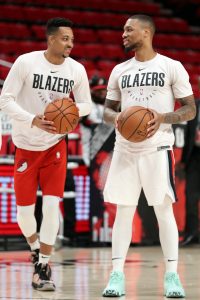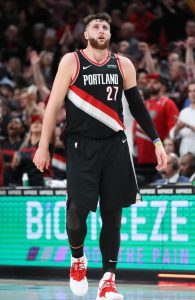After suffering an embarrassing first-round sweep at the hands of the Pelicans in 2018, the Trail Blazers weren’t even considered a lock to make the postseason in 2019. During the preseason, oddsmakers pegged Portland’s over/under at 42.5 wins, ninth in the Western Conference.
The Blazers easily exceeded that total, finishing with a 53-29 mark and claiming the No. 3 seed in the West. Although their season ended once again with a four-game sweep, it happened in the Conference Finals this time around, after they’d eliminated the Thunder with a memorable Damian Lillard buzzer beater and knocked off the Nuggets in a Game 7 in Denver. Portland will enter the 2019/20 season looking to build on that playoff success.
Here are five key questions facing the franchise this summer:
1. How close are the Trail Blazers to legit title contention?
The Trail Blazers didn’t win a single game against the Warriors in the Western Finals, but they built double-digit leads in each of the last three contests and led for most of those games. Now that Golden State will be without Kevin Durant and Klay Thompson for most or all of next season, do the Blazers have an opening to win the West?
Well, yes and no. Portland’s path to the Western Finals was a favorable one, as the team avoided what would have difficult matchups against the Rockets or Jazz. If the bracket had looked a little different, it’s entirely possible that the Blazers could have been eliminated a round or two earlier.
But the West should be more wide open in 2019/20 than it has been in years, so there’s reason for the Blazers to believe they’re just one or two moves away from breaking through. The Raptors, who could have been considered the Blazers of the East in recent years, are a good reference point for Portland — Toronto suffered several postseason disappointments and repeatedly fell short of the NBA Finals before winning a championship in 2019. Maybe the Blazers could follow suit.
Unlike the Raptors, who had to break up their All-Star backcourt to take that next step, I don’t expect the Blazers to seriously consider moving Lillard or CJ McCollum. Instead, it makes more sense for Portland to try to acquire a third impact player using their growing collection of assets. Kevin Love has been a frequent subject of speculation as that impact player, though I expect the Blazers to aim even higher.
There aren’t likely to be teams pushing hard to pry Love from the Cavaliers this summer, and the Blazers could afford to wait until the 2020 trade deadline to try to make a splash if they don’t find a deal they like this offseason, so Love is an option that could be circled back to down the road.
2. What resources do the Blazers have at their disposal to make upgrades?
With nearly $129MM in guaranteed money already on their books for the 2019/20 season, the Trail Blazers will have no cap room. Given their proximity to the projected tax line ($132MM), they probably won’t even be able to comfortably use the full mid-level exception or the bi-annual exception (using either would create a hard cap), meaning the taxpayer’s mid-level exception will be their only real weapon on the free agent market.
There are enough quality free agents hitting the market that Portland could realistically expect to add a solid rotation player using that exception, but it’s not nearly enough to add an impact starter.
If they want to land a player who fits that bill, the Blazers would need to make a trade. And with many of their questionable contract investments from the summer of 2016 set to expire soon, the Blazers could actually put together a pretty intriguing package.
Maurice Harkless ($11.5MM) and Meyers Leonard ($11.3MM) will be on expiring deals that could be used for salary-matching purposes. In Zach Collins, Anfernee Simons, Nassir Little, and – to a lesser extent – Gary Trent and Skal Labissiere, Portland has a group of young prospects that could appeal to trade partners. And the Blazers also hold all their own first-round picks.
Of course, the Blazers are pretty set in the backcourt, and outside of Love, there aren’t currently many impact frontcourt players out there who look like they’d be eminently available via trade. So while we could speculate about possible targets (how about a LaMarcus Aldridge reunion?), we don’t have a clear idea of who the team might pursue.
In many ways, it might make more sense for Portland to be patient and wait until the winter to push its chips all-in. By that point, all of this year’s free agents will once again be trade-eligible, and another disgruntled star or two may have emerged.
3. Will the Blazers be able to re-sign any of their own key free agents?
The Blazers won’t have the resources to go after many outside free agents, but how about their own guys? Can they go over the cap to re-sign them?
Well, there will be no limitations (beyond a willingness to pay tax penalties) if the Blazers want to bring back Al-Farouq Aminu. The club holds his Bird rights and has the flexibility to offer him essentially whatever it takes to retain him.
However, Portland doesn’t have that same flexibility with other key free agents like Enes Kanter, Seth Curry, and Rodney Hood. Kanter and Curry signed with Portland on one-year deals and Hood agreed to be traded after signing a one-year deal of his own, so all three players have Non-Bird rights. That means the Blazers have a limited ability to offer them raises, and can’t realistically expect to bring them back unless they’re willing to accept discounts or perhaps sign for the taxpayer mid-level ($5.7MM).
Curry and Hood emerged as key pieces on the wing for Portland, and Kanter played a huge role in Jusuf Nurkic‘s absence. The Blazers have young players that could conceivably fill those roles – Collins, Little, and Simons – but given their championship aspirations, they’ll likely want to try to add some veteran reinforcements too, rather than relying too heavily on young prospects. It’ll be interesting to see how they do it — their recent trade for Kent Bazemore was a good start.
4. How much can the Blazers expect from Jusuf Nurkic (and Zach Collins) next season?
Speaking of Nurkic, he continues to recover from his broken left leg and isn’t expected to be ready for the start of the 2019/20 season. The Blazers haven’t offered any sort of specific timeline for his return, but reporter Jason Quick speculated last month that the veteran center may not be ready to play until around the 2020 All-Star break.
If that’s the case, the Blazers will need to figure out how they’ll handle the center position for much of the season. The team likes Collins a lot, and if he can make a third-year leap, it’d go a long way toward filling that hole up front. If Leonard sticks around, he can potentially play a role as well — especially if he can build on that shocking 30-point performance vs. the Warriors in Portland’s last game of the season.
Still, with Nurkic sidelined and Kanter potentially heading elsewhere, that’s a pretty thin center rotation. The Blazers should be on the lookout for under-the-radar free agent targets who might be able to help out up front. A player like Amir Johnson, Daniel Theis, Tyson Chandler, or Kyle O’Quinn could help bridge the gap until Nurkic returns. Nene could also be a decent option if he’s a casualty of the Rockets’ roster shakeup.
With Aminu, Curry, and Hood heading for free agency, the Blazers will likely prefer to use their taxpayer MLE on a wing, but their frontcourt shouldn’t be overlooked.
5. Will Damian Lillard sign a super-max extension?
As a result of earning All-NBA honors this season, Lillard became eligible to sign a Designated Veteran Extension – also known as the “super-max” – this offseason. And a report in May indicated that the Blazers plan to offer it.
Lillard still has two years left on his current contract, so a super-max extension wouldn’t go into effect until the 2021/22 season. And while the exact value will depend on where that season’s salary cap ultimately lands, the extension currently projects to be worth about $191MM over four years.
Based on what we’ve seen from Lillard during the last few years, it’s hard to argue that he doesn’t deserve that commitment from Portland. He has spent his career in the city and with the team, and the franchise will want to reward his loyalty — and his All-NBA caliber play.
Still, if we’re being pragmatic about Lillard’s value, it’s worth noting that he’ll turn 29 this July, meaning his four-year super-max extension would cover his age 31-to-34 seasons. It’s possible he’ll remain very productive during those seasons, but a lot could change between now and 2021, when the extension would begin. John Wall, for instance, tore his Achilles between signing his own super-max deal (in 2017) and actually having that extension go into effect (next week).
It’s a tough spot for the Blazers, who would probably rather wait a year or two to make that sort of investment, but won’t want to alienate their star player by refusing to put that offer on the table this year. I expect the two sides to finalize a super-max deal — after that, it’s a matter of waiting and seeing how it turns out.
Check out the Portland Trail Blazers’ offseason salary cap outlook right here.
Salary information from Basketball Insiders was used in the creation of this post. Photos courtesy of USA Today Sports Images.
Great article! You can be sure Portland, well coached, managed and talented enough to be a force as-is; throw in another major component and they become a beast in the west to contend with. Interesting to see how their offseason plays out.
They didn’t get the easier side of the bracket. They played the Thunder and then the Nuggets, who were the #2 seed. At the time, when they won the last game of the season against Sacramento, people were expecting them to throw that game to get the #4 seed and a matchup against the Jazz instead of the Thunder. The narrative always changes, but at the end of the day this team made the Western Conference Finals and led the majority of the series against the Warriors. Did the Nuggets, Rockets, or Jazz make it that far? The answer is no.
They will want to get a look at Love before pushing for a trade. But it doesn’t need to be a long look. I predict 3 weeks in.
The Bazemore trade is a huge help, and good backup centers are floating around.
It is risky to rely on renting other teams’ capspace…
You’re a fool if you think Lillard won’t be in Portland his entire career. He and the Blazers have made it clear thats the plan.